
Developing a Management Roadmap for the Next Administration
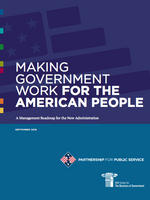 The next occupant of the Oval Office will need to transform campaign promises and a long list of priorities into real policies and programs that produce positive outcomes for the American people.
The next occupant of the Oval Office will need to transform campaign promises and a long list of priorities into real policies and programs that produce positive outcomes for the American people.
The success of an administration can rise—and fall—based on its competence in managing the government. As history demonstrates, strong management can enable rapid and positive results, while management mistakes can derail important policy initiatives, erode public trust and undermine confidence in the government.
During 2016, the Partnership for Public Service and the IBM Center for The Business of Government joined together in sponsoring a series of day-long discussions to inform the next president and the new administration about critical management issues and actions that can strengthen government’s capacity to address the challenges facing our country.
Participants included current and former political and career leaders from the executive and legislative branches, subject-matter experts from the public and private sectors, and representatives from good-government organizations and the academic community. Each of the discussions focused on a key theme: Leadership Talent, Enterprise Government, Driving Innovation, Enhanced Decision-Making and Getting Things Done.
Through these discussions, accompanying reports and related research, we have developed a management roadmap, "Making Government Work for the American People," for the next administration.
In "Making Government Work for the American People," we provide a roadmap for creating a robust management roadmap that includes four basic themes:
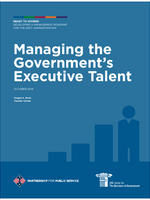
Managing the Government’s Executive Talent by Douglas A. Brook and Maureen Hartney, Duke University.
For the next administration, the management of the federal workforce—including executives—will be a critical factor in the president’s success. The president’s political appointees will work with members of the career Senior Executive Service (SES) to direct the work of agencies and departments.
Part I of this whitepaper presents insights and options for effectively managing executive talent that stem from the roundtable discussion with senior current and former government leaders. In Part II, the whitepaper authors offer a framework for the next administration to manage and harness the talent of top political and career executives in order to accelerate the achievement of presidential priorities. They highlight four key actions that should be undertaken by the next Administration if it wants to get off to a quick start in implementing its agenda.
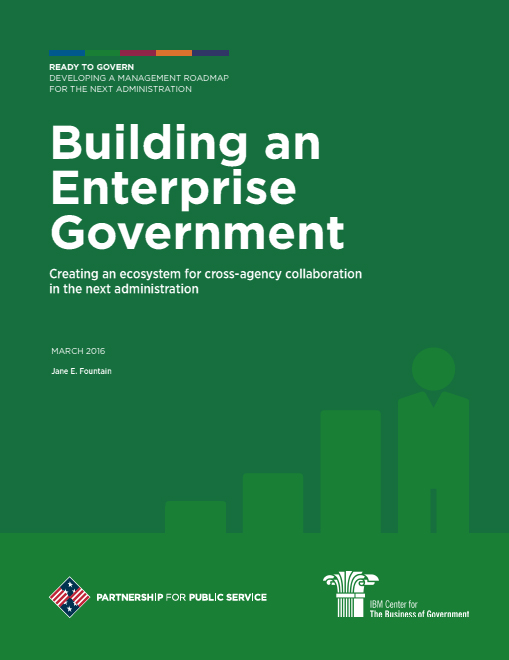
Building an Enterprise Government by Jane Fountain, University of Massachusetts Amherst
In January 2017, the next administration will begin the hard work of implementing the President’s priorities. Regardless of the specific policies, implementation in many cases will require working across agency boundaries. By taking an “enterprise government” approach – starting in the transition and continuing into the White House – the next administration can deliver on their promises more effectively. In this report, Jane Fountain lays out recommendations and a framework for how the new administration can build an enterprise government.
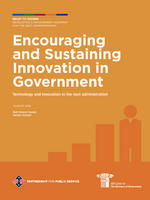
This paper provides analysis and a set of concrete recommendations, both for the period of transition before the inauguration, and for the start of the next presidency, to encourage and sustain innovation in government. Part I of this report presents observations and recommendations on effciency and effectiveness; the customer experience; citizen engagement; and innovation through leadership and talent, process, scale and governance. Part II takes stock of past experiences in the use of technology and innovation in government. The next administration will have the opportunity to build on progress from past administrations – from President George W. Bush’s e-government initiatives to the many efforts undertaken by the Obama administration. The final part offers a series of five broad recommendations and 10 specific and implementable actions to institutionalize a culture of innovation.
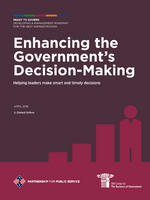
- Read an introductory blog by Dan Chenok and Alan Howze to learn more about the beginnings of this initiative as well as a Washington Post editorial and our own The Business of Government magazine article about the Ready to Govern initiative.
- Learn about our first roundtable where we brought together academic and practitioner experts to discuss the management and leadership priorities that will informed the content for the Management Roadmap.
- Read the Government Executive article about our final roundtable, "A Quick Start for the Next Administration" where we brought together current and former senior officials from administrations of both parties, as well as experts from academia and the private and non-profit sectors. The robust discussion surfaced a number of practical actions that a new administration can set into motion, starting with the transition period, to increase the likelihood of a successful first year. Out of the discussion emerged actions that transition teams can take to increase the likelihood of a successful first year.
Transition Related Materials
Part I contains seven “to-dos” necessary to “get it done” in Washington. Part II consists of 14 chapters, each describing an important stakeholder in the political environment of Washington.
New government leaders have a great opportunity to make a positive difference for the nation. We hope that the 2017 edition to Getting It Done will prove useful in helping them to achieve success.
Watch the video of our book launch and panel discussion.
 The Best Transition In History - Presidential scholar Dr. Martha Kumar writes on best practices in Presidential transitions and the importance of focusing on management in the transition and early days of an administration. Read our blog post on Dr. Kumar's book.
The Best Transition In History - Presidential scholar Dr. Martha Kumar writes on best practices in Presidential transitions and the importance of focusing on management in the transition and early days of an administration. Read our blog post on Dr. Kumar's book.




